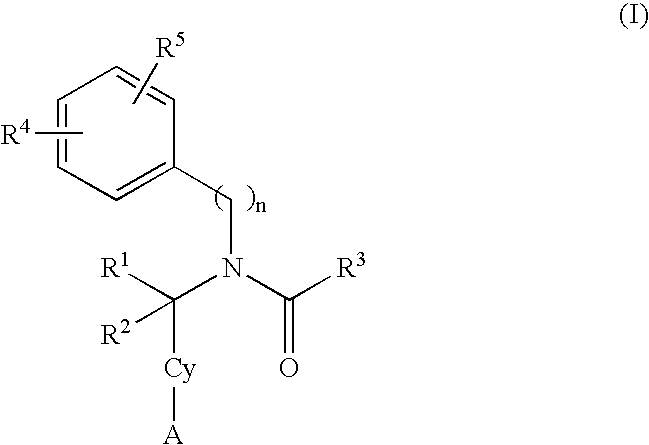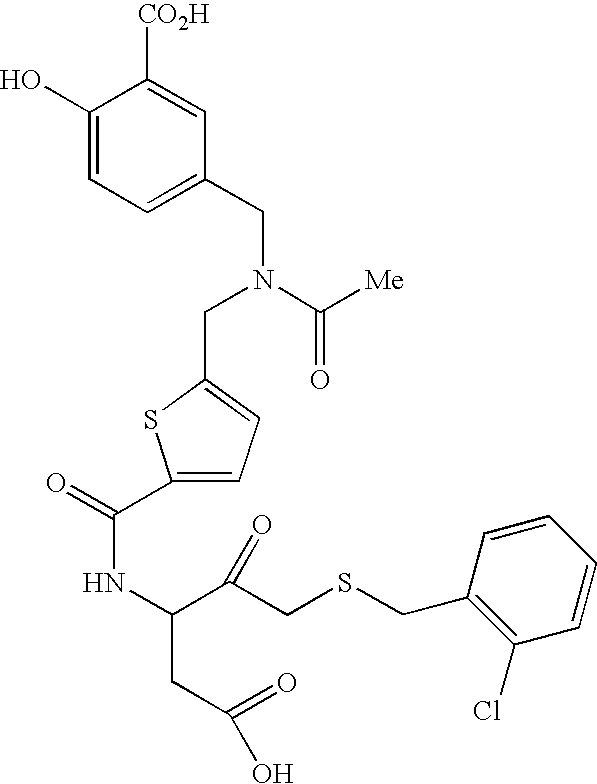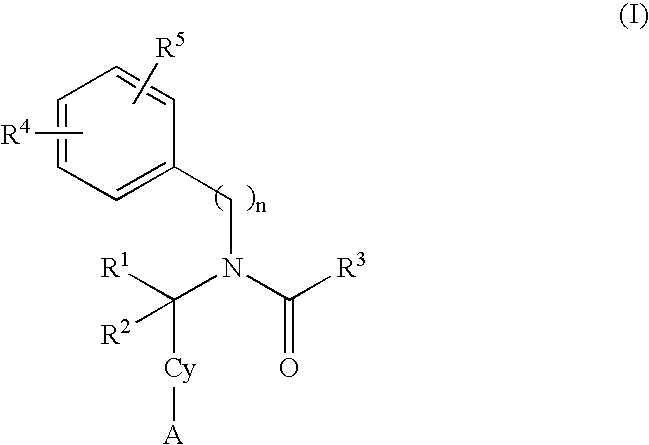Aryl dicarboxamides
a technology of dicarboxamide and aryl dicarboxamide, which is applied in the field of aryl dicarboxamide, can solve the problems of increasing the risk of coronary heart diseas
- Summary
- Abstract
- Description
- Claims
- Application Information
AI Technical Summary
Benefits of technology
Problems solved by technology
Method used
Image
Examples
example 1
5-[(3-cyclopentylpropanoyl)(4-{[(4-phenoxybenzyl)amino]carbonyl}benzyl)amino]-2-hydroxybenzoic acid
Step a) Formation of benzyl 4-{[(2,2-dimethyl-4-oxo-4H-1,3-benzodioxin-6-yl)amino]-methyl}benzoate
[0265]
[0266] A solution of 4-formylbenzoate (481 mg) and 6-amino-2,2-dimethyl-4H-1,3-benzodioxin-4-one (386 mg) in toluene (20 mL) was heated at reflux for 12 h with azeotropic removal of water. The toluene was evaporated off under reduce pressure, the residue was taken up in methanol (10 mL) and cooled to 0° C. NaBH4 (114 mg) was added portionwise and the reaction mixture was stirred at 0° C. for 1 h then at rt for 2 h. The reaction mixture was poured into water and resulting mixture extracted with Et2O. The combined organic layers were washed with brine, dried over MgSO4 and filtered. The solvent was removed under reduce pressure to give the crude product as an oil. The product was purified by flash chromatography (SiO2, EtOAc / c-Hex 20 / 80) to give the title compound as a colorless oil ...
example 2
5-[(3-cyclopentylpropanoyl)(4-{[(4-phenoxybenzyl)amino]carbonyl}-benzyl)amino]-2-hydroxybenzoic acid, N-methyl-D-glucamine (i.e. 1-deoxy-1-(methylamino)glucitol) salt
[0275]
[0276] To a solution of 5-[(3-cyclopentylpropanoyl)(4-{[(4-phenoxybenzyl)amino]carbonyl}benzyl)amino]-2-hydroxybenzoic acid (80 mg, 0.135 mmol) in EtOH (5 mL) was added N-methyl-D-glucamine (26.4 mg, 0.135 mmol). The resulting mixture was sired until a homogeneous solution was obtained. The solvent was removed in vacuum and the residue was dissolved in a 9 / 1 mixture of H2O / EtOH. The resulting solution was then lyophilized to afford the title compound as a white powder (70 mg). M+(ESI): 593.0; M−(ESI): 591.0. HPLC, Rt: 4.9 min (purity: 97.0%).
example 3
[4-({{[2-(4-{[(4-pentylbenzyl)amino]carbonyl}phenyl)-1,3-thiazol-4-yl]methyl}[(2E)-3-phenylprop-2-enoyl]amino}methyl)phenoxy]acetic acid
Step a) Formation of 4-[4-(chloromethyl)-1,3-thiazol-2-yl]-N-(4-pentylbenzyl)benzamide
[0277]
[0278] N-methylmorpholine (1.7 mL, 15.3 mmol) and isobutyl chloroformate (1.0 mL, 7.65 mmol) were added to a solution of 4-[4-(chloromethyl)-1,3-thiazol-2-yl]benzoic acid (1.85 g, 7.29 mmol) in anhydrous THF (30 mL) at 0° C. The reaction mixture was stirred at 0° C. for 30 min, then (4-pentylbenzyl)amine hydrochloride (1.64 g, 7.65 mmol) was added neat. The reaction mixture was stirred for 15 min at 0° C., then 2 hours at RT. The reaction mixture was diluted with DCM (100 mL) and washed with 1M aqueous HCl (50 mL), then saturated aqueous NaHCO3 (50 mL). The aqueous layers were extracted with DCM (100 mL). The combined organic layers were dried over MgSO4 and the solvents were removed under reduced pressure to give a brown solid. Recrystallization from a mir...
PUM
| Property | Measurement | Unit |
|---|---|---|
| pH | aaaaa | aaaaa |
| temperature | aaaaa | aaaaa |
| temperature | aaaaa | aaaaa |
Abstract
Description
Claims
Application Information
 Login to View More
Login to View More - R&D
- Intellectual Property
- Life Sciences
- Materials
- Tech Scout
- Unparalleled Data Quality
- Higher Quality Content
- 60% Fewer Hallucinations
Browse by: Latest US Patents, China's latest patents, Technical Efficacy Thesaurus, Application Domain, Technology Topic, Popular Technical Reports.
© 2025 PatSnap. All rights reserved.Legal|Privacy policy|Modern Slavery Act Transparency Statement|Sitemap|About US| Contact US: help@patsnap.com



